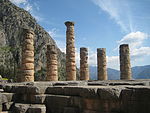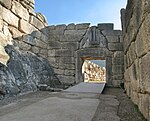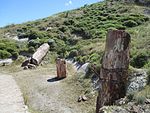গ্রিসের বিশ্ব ঐতিহ্যবাহী স্থানসমূহের তালিকা
এটি গ্রিসের ইউনেস্কো বিশ্ব ঐতিহ্যবাহী স্থানসমূহের একটি তালিকা। আর্মেনিয়ায় ১৮টি বিশ্ব ঐতিহ্যবাহী স্থান আছে।[১] এর মধ্যে ১৬টি সাংস্কৃতিক ও ২টি সাংস্কৃতিক ও প্রাকৃতিক বা মিশ্র স্থান। ৫টি স্থান দ্বীপে অবস্থিত, একটি দ্বীপ ও মূল ভূখণ্ডের মধ্যে বণ্টিত ও ১২টি পুরোপুরি মূল ভূখণ্ডে অবস্থিত। বাসাইয়ে অ্যাপোলোর মন্দির প্রথম তালিকাভূক্ত হয় ১৯৮৬ সালে এবং ২০১৬ সালে অন্তর্ভুক্ত ফিলিপ্পি সর্বশেষ তালিকাভূক্ত স্থান। এছারাও ইউনেস্কোর সাম্ভাব্য ঐতিহ্যবাহী স্থানের তালিকায় আরো ১৪টি স্থান আছে।
গ্রিসের বিশ্ব ঐতিহ্যবাহী স্থানসমূহের তালিকা
[সম্পাদনা]নিম্নোক্ত তালিকায় প্রতিটি বিশ্ব ঐতিহ্যবাহী স্থানের নাম ও বিশদ তথ্য আছে -
- নাম: বিশ্ব ঐতিহ্য কমিটি দ্বারা দেওয়া নাম
- অবস্থান: শহর (অবস্থিত বা নিকটতম), স্থানাঙ্ক
- সময়কাল: তাত্পর্যপূর্ণ সময়কাল, সাধারণত নির্মাণ সময়
- ইউনেস্কো তথ্য: ইউনেস্কো পরিচিতি সংখ্যা, যেই সালে তালিকাভূক্ত করা হয়েছিল, যা অনুযায়ী তালিকাভূক্ত করা হয়েছে
- বর্ণনা: স্থানটির সংক্ষিপ্ত বর্ণনা
| নাম | ছবি | অবস্থান | সময়কাল | ইউনেস্কো তথ্য | বর্ণনা |
|---|---|---|---|---|---|
| অ্যাক্রোপলিস, অ্যাথেন্স (Acropolis, Athens) |

|
অ্যাথেন্স, অ্যাটিকা ৩৭°৫৮′ উত্তর ২৩°৪৪′ পূর্ব / ৩৭.৯৭° উত্তর ২৩.৭৩° পূর্ব[২] |
খ্রিস্টপূর্ব ৫ম শতাব্দী[২] | ৪০৪; ১৯৮৭; i, ii, iii, iv, vi[২] |
A collection of massive, yet perfectly balanced architectural masterpieces in harmony with the natural landscape, the Acropolis of Athens is one of the most important expressions of Classical Greek aesthetics. It was completed by the 5th century BC and has since then exerted a profound influence on architecture worldwide.[২] |
| আইগাই প্রত্নতাত্ত্বিক স্থান (আধুনিক নাম ভার্জিনা) (Archaeological Site of Aigai (modern name Vergina)) |

|
ইমাথিয়া, মধ্য ম্যাসেডোনিয়া ৪০°২৮′ উত্তর ২২°২৬′ পূর্ব / ৪০.৪৭° উত্তর ২২.৪৩° পূর্ব[৩] |
খ্রিস্টপূর্ব প্রথম সহস্রাব্দ[৩] | ৭৮০; ১৯৯৬; i, iii[৩] |
The ancient city of Aigai was the first capital of the Kingdom of Macedon. In addition to the monumental palace, lavishly decorated with mosaics and painted stuccoes, the site contains a burial ground with more than 300 tumuli, one of which has been identified as that of ম্যাসিডনের দ্বিতীয় ফিলিপ, father of মহান আলেকজান্ডার.[৩] |
| ডেলফি প্রত্নতাত্ত্বিক স্থান (Archeological site of Delphi) |

|
ফোকিস, মধ্য গ্রিস ৩৮°২৯′ উত্তর ২২°৩০′ পূর্ব / ৩৮.৪৮° উত্তর ২২.৫° পূর্ব[৪] |
খ্রিস্টপূর্ব অস্টম শতাব্দী[৪] | ৩৯৩; ১৯৮৭; i, ii, iii, iv, vi[৪] |
The pan-Hellenic sanctuary of Delphi, location of the oracle of অ্যাপোলো, was the spiritual center of the Greek world. Situated in a spectacular natural setting at the foot of Mount Parnassus, it was a symbol of Greek cultural unity from the 8th century BC onwards.[৪] |
| মিস্ট্রাস প্রত্নতাত্ত্বিক স্থান (Archeological site of Mystras) |

|
Laconia, Peloponnese ৩৭°০৫′ উত্তর ২২°২২′ পূর্ব / ৩৭.০৮° উত্তর ২২.৩৭° পূর্ব[৫] |
13th century AD[৫] | ৫১১; ১৯৮৯; ii, iii, iv[৫] |
Long known as "the Wonder of the Morea", the remarkably well-preserved medieval city of Mystras played a central role in the final years of the বাইজেন্টাইন সাম্রাজ্য. Built on a steep hill at the foot of Mount Taygetus, it was the last Byzantine stronghold to fall to the উসমানীয়, holding out until 1461. |
| ওলিম্পিয়া প্রত্নতাত্ত্বিক স্থান (Archeological site of Olympia) |

|
Elis, West Greece ৩৭°৩৮′ উত্তর ২১°৪০′ পূর্ব / ৩৭.৬৪° উত্তর ২১.৬৭° পূর্ব[৬] |
10th century BC[৬] | ৫১৭; ১৯৮৯; i, ii, iii, iv, vi[৬] |
The site of Olympia, built on the banks of the Alpheios river in the Peloponnese, was the location of the প্রাচীন অলিম্পিক গেমস beginning in 776 BC. In addition to numerous temples and sanctuaries, it contains the remains of several sporting structures, such as its famous stadium. |
| মাইসিনাই ও টাইরিন্স প্রত্নতাত্ত্বিক স্থান (Archeological site of Mycenae and Tiryns) |

|
Argolis, Peloponnese ৩৭°৩৮′ উত্তর ২২°৪৫′ পূর্ব / ৩৭.৬৪° উত্তর ২২.৭৫° পূর্ব[৭] |
15th century BC[৬] | ৯৪১; ১৯৯৯; i, ii, iii, iv, vi[৭] |
Mycenae and Tiryns were two of the most important cities of Mycenean Greece, which flourished between the 15th and 12th centuries BC. The Lion's Gate and Treasury of Atreus at Mycenae have been listed as "outstanding examples of human creative genius". |
| ডেলোস (Delos) |

|
Cyclades, South Aegean ৩৭°২৩′ উত্তর ২৫°১০′ পূর্ব / ৩৭.৩৯° উত্তর ২৫.১৬° পূর্ব[৮] |
7th century BC[৮] | ৫৩৯; ১৯৯০; ii, iii, iv, vi[৮] |
The birthplace of অ্যাপোলো and আর্তেমিস according to Greek mythology, the sacred island of Delos was one of the most important pan-Hellenic sanctuaries. The sanctuary of Apollo on Delos attracted pilgrims from all over Greece, making Delos a prosperous trading port. |
| ঐতিহাসিক কেন্দ্র (চোরা) এবং ধর্মতত্ত্ববিদ সন্ত জনের মঠ (Historic Centre (Chora) with the Monastery of Saint John) |

|
Patmos, South Aegean ৩৭°১৮′৩৩″ উত্তর ২৬°৩২′৫৩″ পূর্ব / ৩৭.৩০৯১৮৯° উত্তর ২৬.৫৪৮০৫৩° পূর্ব[৯] |
10th century[৯] | ৯৪২; ১৯৯৯; iii, iv, vi[৯] |
The small island of Pátmos in the Dodecanese is reputed to be where St John the Theologian wrote both his Gospel and the Apocalypse. A monastery dedicated to the ‘beloved disciple’ was founded there in the late 10th century and it has been a place of pilgrimage and Greek Orthodox learning ever since. The fine monastic complex dominates the island. The old settlement of Chorá, associated with it, contains many religious and secular buildings. |
| মধ্যযুগীয় রোডস শহর (Medieval City of Rhodes) |

|
Rhodes, South Aegean ৩৬°২৬′০০″ উত্তর ২৮°১৩′০০″ পূর্ব / ৩৬.৪৩৩৩৩৩° উত্তর ২৮.২১৬৬৬৭° পূর্ব[১০] |
৪৯৩; ১৯৮৮; ii, iv, v[১০] |
The Order of St John of Jerusalem occupied Rhodes from 1309 to 1523 and set about transforming the city into a stronghold. It subsequently came under Turkish and Italian rule. With the Palace of the Grand Masters, the Great Hospital and the Street of the Knights, the Upper Town is one of the most beautiful urban ensembles of the গথিক শিল্প. In the Lower Town, Gothic architecture coexists with mosques, public baths and other buildings dating from the উসমানীয় সাম্রাজ্য period. | |
| ডাফনি মঠসমূহ, হোসিওস লৌকাস এবং চিওসের নিয়া মোনি (Monasteries of Daphni, Hosios Loukas and Nea Moni of Chios) |
  
|
Hosios Loukas: Distomo, Boeotia ৩৮°২৩′৪১″ উত্তর ২২°৪৪′৪৮″ পূর্ব / ৩৮.৩৯৪৭২২° উত্তর ২২.৭৪৬৬৬৭° পূর্ব Daphni Monastery: Chaidari, Attica ৩৮°০০′৪৭″ উত্তর ২৩°৩৮′০৯″ পূর্ব / ৩৮.০১৩০৫৬° উত্তর ২৩.৬৩৫৮৩৩° পূর্ব Nea Moni: Chios, North Aegean ৩৮°২২′২৬″ উত্তর ২৬°০৩′২১″ পূর্ব / ৩৮.৩৭৩৯০৬° উত্তর ২৬.০৫৫৭৩৯° পূর্ব[১১] |
11th and 12th centuries[১১] | ৫৩৭; ১৯৯০; i, iv[১১] |
Although geographically distant from each other, these three monasteries belong to the same typological series and share the same aesthetic characteristics. The churches are built on a cross-in-square plan with a large dome supported by squinches defining an octagonal space. In the 11th and 12th centuries they were decorated with superb marble works as well as mosaics on a gold background, all characteristic of the 'second golden age of Byzantine art'. |
| করফু পুরনো শহর (Old Town of Corfu) |

|
Corfu, Ionian Islands ৩৯°৩৭′০০″ উত্তর ১৯°৫৫′০০″ পূর্ব / ৩৯.৬১৬৬৬৭° উত্তর ১৯.৯১৬৬৬৭° পূর্ব[১২] |
8th century BC[১২] | ৯৭৮; ২০০৭; iv[১২] |
The Old Town of Corfu, on the Island of Corfu off the western coasts of আলবেনিয়া and Greece, is located in a strategic position at the entrance of the অ্যাড্রিয়াটিক সাগর, and has its roots in the 8th century BC. The three forts of the town, designed by renowned Venetian engineers, were used for four centuries to defend the maritime trading interests of the Republic of Venice against the উসমানীয় সাম্রাজ্য. In the course of time, the forts were repaired and partly rebuilt several times, more recently under British rule in the 19th century. The mainly neoclassical housing stock of the Old Town is partly from the Venetian period, partly of later construction, notably the 19th century. As a fortified Mediterranean port, Corfu’s urban and port ensemble is notable for its high level of integrity and authenticity. |
| থেসালোনিকির আদি খ্রিষ্টীয় ও বাইজেন্টাইন মিনারসমূহ (Paleochristian and Byzantine monuments of Thessaloniki) |

|
Thessaloniki, Central Macedonia ৪০°৩৯′ উত্তর ২২°৫৪′ পূর্ব / ৪০.৬৫° উত্তর ২২.৯° পূর্ব[১৩] |
315 B.C.[১৩] | ৪৫৬; ১৯৮৮; i, ii, iv[১৩] |
Founded in 315 B.C., the provincial capital and sea port of Thessalonika was one of the first bases for the spread of Christianity. Among its Christian monuments are fine churches, some built on the Greek cross plan and others on the three-nave basilica plan. Constructed over a long period, from the 4th to the 15th century, they constitute a diachronic typological series, which had considerable influence in the বাইজেন্টাইন সাম্রাজ্য. |
| পাইথাগোরিয়ান ও সামোসের হেরাইওন (Pythagoreion and Heraion of Samos) |

|
Samos, North Aegean ৩৭°৪২′০৪″ উত্তর ২৬°৫২′০৮″ পূর্ব / ৩৭.৭০১২০৮° উত্তর ২৬.৮৬৮৭৮৩° পূর্ব[১৪] |
3rd millennium B.C.[১৪] | ৫৯৫; ১৯৯২; ii, iii[১৪] |
Many civilizations have inhabited this small Aegean island, near আনাতোলিয়া, since the 3rd millennium B.C. The remains of Pythagoreion, an ancient fortified port with Greek and Roman monuments and a spectacular tunnel-aqueduct, as well as the Heraion, temple of the Samian Hera, can still be seen. |
| এপিডাউরসে অ্যাস্ক্লপিওসের উপাসনার স্থান (Sanctuary of Asklepios at Epidaurus) |

|
Epidaurus, Peloponnese ৩৭°৩৮′০০″ উত্তর ২৩°০৮′০০″ পূর্ব / ৩৭.৬৩৩৩৩৩° উত্তর ২৩.১৩৩৩৩৩° পূর্ব[১৫] |
4th century[১৫] | ৪৯১; ১৯৮৮; i, ii, iii, iv, vi[১৫] |
In a small valley in the Peloponnesus, the shrine of আস্ক্লেপিউস, the god of medicine, developed out of a much earlier cult of অ্যাপোলো, during the 6th century BC at the latest, as the official cult of the city state of Epidaurus. Its principal monuments, particularly the temple of Asklepios, the Tholos and the Theatre - considered one of the purest masterpieces of Greek architecture – date from the 4th century. The vast site, with its temples and hospital buildings devoted to its healing gods, provides valuable insight into the healing cults of Greek and Roman times. |
| বাসাইয়ে অ্যাপোলো এপিকিউরিয়াসের মন্দির (Temple of Apollo Epicurius at Bassae) |

|
Bassae, Messenia, Peloponnese ৩৭°২৫′৪৭″ উত্তর ২১°৫৪′০১″ পূর্ব / ৩৭.৪২৯৭২২° উত্তর ২১.৯০০২৭৮° পূর্ব[১৬] |
5th century B.C.[১৬] | ৩৯২; ১৯৮৬; i, ii, iii, iv, vi[১৬] |
This famous temple to the god of healing and the sun was built towards the middle of the 5th century B.C. in the lonely heights of the Arcadian mountains. The temple, which has the oldest Corinthian capital yet found, combines the Archaic style and the serenity of the Doric style with some daring architectural features. |
| মিটিওরা (Meteora) |

|
near Kalabaka, Thessaly ৩৯°৪২′৫১″ উত্তর ২১°৩৭′৫২″ পূর্ব / ৩৯.৭১৪১৬৭° উত্তর ২১.৬৩১১১১° পূর্ব[১৭] |
৪৫৫; ১৯৮৮; i, ii, iv, v, vii[১৭] |
In a region of almost inaccessible sandstone peaks, monks settled on these 'columns of the sky' from the 11th century onwards. Twenty-four of these monasteries were built, despite incredible difficulties, at the time of the great revival of the eremetic ideal in the 15th century. Their 16th-century frescoes mark a key stage in the development of post-Byzantine painting. | |
| এথোস পর্বত (Mount Athos) |

|
Autonomous Monastic State of the Holy Mountain ৪০°০৯′২৬″ উত্তর ২৪°১৯′৩৫″ পূর্ব / ৪০.১৫৭২২২° উত্তর ২৪.৩২৬৩৮৯° পূর্ব[১৮] |
৪৫৪; ১৯৮৮; i, ii, iv, v, vi, vii[১৮] |
An Orthodox spiritual centre since 1054, Mount Athos has enjoyed an autonomous statute since বাইজেন্টাইন সাম্রাজ্য times. The 'Holy Mountain', which is forbidden to women and children, is also a recognized artistic site. The layout of the monasteries (about 20 of which are presently inhabited by some 1,400 monks) had an influence as far afield as রাশিয়া, and its school of painting influenced the history of Orthodox art. | |
| ফিলিপ্পি (Philippi) |

|
Philippi, Kavala, Eastern Macedonia ৪১°০০′৪৭″ উত্তর ২৪°১৭′১১″ পূর্ব / ৪১.০১৩০৫৬° উত্তর ২৪.২৮৬৩৮৯° পূর্ব[১৯] |
4th century B.C. - 14th century A.D [১৯] | ১৫১৭; ২০১৬; iii, iv[১৯] |
The remains of this walled city lie at the foot of an acropolis in the present-day region of Eastern Macedonia and Thrace, on the ancient route linking Europe and Asia, the Via Egnatia. Founded in 356 BC by the Macedonian King দ্বিতীয় ফিলিপ, the city developed as a “small Rome” with the establishment of the রোমান সাম্রাজ্য in the decades following the Battle of Philippi, in 42 BCE. The Hellenistic theatre and funerary heroon (temple) were supplemented with Roman buildings such as the forum. Later the city became a centre of the Christian faith following the visit of the Apostle Paul in 49-50 CE. The remains of its basilicas constitute an exceptional testimony to the early establishment of Christianity. |
সম্ভাব্য তালিকা
[সম্পাদনা]এই নিবন্ধটি বাংলায় অনুবাদ করা প্রয়োজন। এই নিবন্ধটি বাংলা ব্যতীত অন্য কোন ভাষায় লেখা হয়েছে। নিবন্ধটি যদি ঐ নির্দিষ্ট ভাষা ব্যবহারকারীদের উদ্দেশ্যে লেখা হয়ে থাকে তবে, অনুগ্রহ করে নিবন্ধটি ঐ নির্দিষ্ট ভাষার উইকিপিডিয়াতে তৈরি করুন। অন্যান্য ভাষার উইকিপিডিয়ার তালিকা দেখুন এখানে। এই নিবন্ধটি পড়ার জন্য আপনি গুগল অনুবাদ ব্যবহার করতে পারেন। কিন্তু এ ধরনের স্বয়ংক্রিয় সরঞ্জাম দ্বারা অনুবাদকৃত লেখা উইকিপিডিয়াতে সংযোজন করবেন না, কারণ সাধারণত এই সরঞ্জামগুলোর অনুবাদ মানসম্পন্ন হয় না। |
| Year | Name | Region | Image |
|---|---|---|---|
| 2014 | Late Medieval Bastioned Fortifications in Greece | Ionian islands,Peloponnese, Crete, South Aegean, North Aegean |  |
| 2014 | National Park of Dadia – Lefkimi – Souflion | East Macedonia and Thrace |  |
| 2014 | Ancient Lavrion | Attica |  |
| 2014 | Petrified forest of Lesvos | North Aegean |  |
| 2014 | Archeological site of ancient Messene | Peloponnese |  |
| 2014 | Minoan palatial centres (Knossos, Phaistos, Malia, Zakros, Kydonia | Crete |  |
| 2014 | Archeological site of Nikopolis | West Greece |  |
| 2014 | The broader region of Mount Olympus | Thessaly, Central Macedonia |  |
| 2014 | The area of the Presper Lakes: Megali and Mikri Prespa which incloudes Byzantines and post – Byzantine monuments | West Macedonia |  |
| 2014 | Gorges of Samaria National Park | Crete |  |
| 2014 | Fortress of Spinalonga | Crete |  |
| 2014 | Ancient towers of the Aegean sea | North Aegean, South Aegean |  |
তথ্যসূত্র
[সম্পাদনা]- ↑ Greece: Properties inscribed on the World Heritage List, UNESCO, সংগ্রহের তারিখ ২০১২-০১-১৩
- ↑ ক খ গ ঘ Acropolis, Athens, UNESCO, সংগ্রহের তারিখ ২০১২-০১-১৩
- ↑ ক খ গ ঘ Archaeological Site of Aigai (modern name Vergina), UNESCO, সংগ্রহের তারিখ ২০১২-০১-১৩
- ↑ ক খ গ ঘ Archeological site of Delphi, UNESCO, সংগ্রহের তারিখ ২০১২-০১-২৫
- ↑ ক খ গ Archeological site of Mystras, UNESCO, সংগ্রহের তারিখ ২০১২-০২-০৭
- ↑ ক খ গ ঘ Archeological site of Olympia, UNESCO, সংগ্রহের তারিখ ২০১২-০২-০৭
- ↑ ক খ Archeological site of Mycenae and Tiryns, UNESCO, সংগ্রহের তারিখ ২০১২-০২-০৭
- ↑ ক খ গ Delos, UNESCO, সংগ্রহের তারিখ ২০১২-০২-০৭
- ↑ ক খ গ Historic Centre (Chorá) with the Monastery of Saint John, UNESCO, সংগ্রহের তারিখ ২০১২-০৯-৩০
- ↑ ক খ Medieval City of Rhodes, UNESCO, সংগ্রহের তারিখ ২০১২-০৯-৩০
- ↑ ক খ গ Monasteries of Daphni, Hosios Loukas and Nea Moni of Chios, UNESCO, সংগ্রহের তারিখ ২০১২-০৯-৩০
- ↑ ক খ গ Old Town of Corfu, UNESCO, সংগ্রহের তারিখ ২০১২-০৯-৩০
- ↑ ক খ গ Paleochristian and Byzantine Monuments of Thessalonika, UNESCO, সংগ্রহের তারিখ ২০১২-০৯-৩০
- ↑ ক খ গ Pythagoreion and Heraion of Samos, UNESCO, সংগ্রহের তারিখ ২০১২-০৯-৩০
- ↑ ক খ গ Sanctuary of Asklepios at Epidaurus, UNESCO, সংগ্রহের তারিখ ২০১২-০৯-৩০
- ↑ ক খ গ Temple of Apollo Epicurius at Bassae, UNESCO, সংগ্রহের তারিখ ২০১২-০৯-৩০
- ↑ ক খ Meteora, UNESCO, সংগ্রহের তারিখ ২০১২-০৯-৩০
- ↑ ক খ Mount Athos, UNESCO, সংগ্রহের তারিখ ২০১২-০৯-৩০
- ↑ ক খ গ Archaeological Site of Philippi, UNESCO, সংগ্রহের তারিখ ২০১৬-০৭-১৫
- ↑ http://whc.unesco.org/en/statesparties/gr

